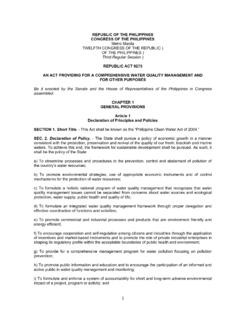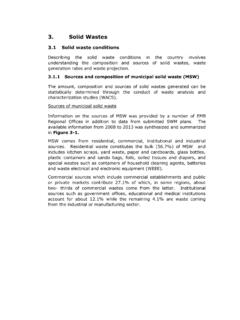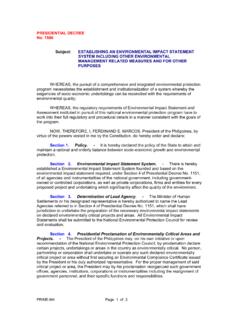Transcription of &a
1 Republic of the Philippines&aDepartmentofEnvironment and Natural Raources Visayas Avenue, IMiman, Quezon City TeI. Nos. <633)9204301 * (632) 928-0691 to 93 --924-2540 * 928-8392 * 9294626 ;2 I35 Website: hnp- / Email: DEC 11 4 2013 DENR ADMINISTRATIVE ORDER ,ZZ Subject: REVISED PROCEDWS AND STANDARDS FOR THJl MANAGEMENT OF HAZARDOUS WASTES (REVISING DAO 2004-36) Pursuant to Rqnrblic Act otherwise known as the "Toxic Substances and Hdous and Nuclear Waste Control Act of 1990, Executive Order No. 192 Series of 1984, and DENR Administrative Order , "Revising DENR Admhkhtive Order No. 29, Series of 1992, to Further Strengthen the Implementation ofRepublic Act 6969 and Prescribing the Use ofthe Procedural Manual.", the Procedural Manual for Hazardous Waste Management is hereby revised. Section I. Basic Policy It is the policy of the State to regulate, restrict or phibit the importation, manufacture, processing, sale, distribution, use and disposal of chemical substances and mixtures that present unreasonablerisk and/or injury to health or the environment; to prohibit the entry, even in transit, of hazardousand nuclear wastes and their disposal in the Philippine territorial limits for whatever purpose; and to provide advancement and facilitate research and studies on toxic chemicals and h&dous and nuclear wastes.
2 Sec. 2. Objectiv~.This AdminisbativeOrder shall have the following objectives: a. Ensure that the impomt aspects of the Title 111 of DENR Administrative Order 92-29 (Implementing Rules and Regulations of RA 6969), particularly the requirements for hazardous waste generators, bansporters and treaters developed and presented in a useful informatiad reference document forvarious stakeholders; and b. Further streamline procedures for generation and compliance to the legal and technical requirements for hdous waste management in the light of recent developments. Set. 3. Scope and Covemge. This Order shall revise the following provisions of DENR Administrative Order 2002-36: I. Definition of Tenns Chapter 1 2. Classificationof Hazardous Wastes Chapter 2 3. Waste Generators Chapter 3 4. Waste Transporters Chapter 4 5. Treabnent, Storage and disposal Facilities Chapter 5 6. Storage and Labeling Chapter 6 7. WasteT~rtRecord Chapter 7 8. Contingency Program Chapter 8 9.
3 Pasomel Training Chapter 9 10. Import of Recyclable Materials Contai~ng Chapter 10 Hazardous Substances and Export of Hazardous Wastes 1 1. Prohibited Acts and Penalties Chapter 11 12. Monitoring Chapter I2 13. Schedule of Fees Chapter t 3 @ -:z; .-;-"-w+ 1-rn . ". d The Revised Procedural Manual grescribing detailed requirements and procedures for hazardous waste management is hereby appended and forms an integral part of this Order. Sec. 4. Separabiity Clause. If any section or provision of these Rules and Regulations or that of the Revised Procedural Manual is held or declared unconstitutional or invalid by a competent court, the other sections or provisions hereof shall continue to be in force as if the sections or provisions so mulled ox voided had never been incorporated herein. Sec. 5. Rep-lhg Clause. All Mes and Regulations nr parts of said rules and regulations or pertinent laws inconsistent with these Rules and Regulations are hereby revised, amended, modified andlor superseded as the case may be by this Order.
4 Sec 6. Amendments. These Rules and Regulations and the Revised Procedural. Manual may be amended and/or modified from time to time by the Department of Environment and Natural Resources. Sec. 7. Effectivity. This Order shall take effect fifteen (15) days after its publication in a newspaper of general. circulation and upon acknowIedgmtnt of receipt of a copy hereof by the Ofice of the National Adminimtive Register (ONAR). y Secretary Publication: Halaga Deoember If, 2013 AobodedUementg QNAR, kw Center r' December 16, 2013 Revised Procedures and Standards for the Management of Hazardous Wastes . lRevisine DAO 2004-361 Con tents FOREWORD .. I DEFINITION OF TERMS .. 2 .. CLASSIFICATION OF IIALARDOUS WASTES 9 ) GOVERIYlNC RULES AND REGU LATlONS FOR HAZARDOUS WASTE GENER4 TOHS GOVERKINC RULES AND KECULAI'IONS FOR HAZARDOUS WASTE . TRANSPORTERS .. 24 ) GOVERNING RULES AND REGULA'PIONS YOU HALARDOClS WASTE: TREATMENT. STORAGE AND DISPDSA L (TSD) FACILITIES.
5 31 HAZARDOUS WASTE STORAGE AND LABELING .. 38 HAZARDOIIS WASTE TRANSPORT RECOHD (MANIFEST SYSTEM) .. 48 Revised Procedures and Standards for the Management of Hazardous Wastes (Rewising DAO 2004-361 .. C0 NTlNCENC:Y PROGRAM SO PERSONNEL TRAINING .. 53 IMPORT OF RECYCL. ABLE MATERIALS CONTAINING HAZARDOUS SU BSTANC'ES AND EXPORT OF HAZARDOUS WASTES .. 54 1 PROHIBITED ACTS AND PENALTIES .. 63 ) MONITORLNC .. 65 SCHEDULE OF FEES .. hfi Appendices 1 Onl~n!. Hazxdous Waste Registratlor1 aid Manifest System Manual 2 Hazardolls Waste Matlifest System Process Flow Revised Procedures and Standards for the Management of Hazardous Wastes IRewising DAO 2004-361 FOREWORD l'11js Reviscd Procedural Manual seeks to collate and streamline the existing rules and regulations of Hazardous Wastes Management. Its main oh,jectives are to: a. Prtlvide a singular procrdu ral manual on the: Implementing Rules and Regulations of Republic Act 6969 b. Be able to c,ontinuou sly monitor the generation, transport, treatmen I, storage, and disposal of hazardous wastes, in order to avoid environmental contamination c.
6 Provide a primary reference for DENR and EMB staff or personnel, existing ,and prospective waste gpnerators, transporters, and treaters, environrnen tal units of t agencies, locA government officials, non-governmental or people's organization, and other stakeholders in the effective implementation of proper haza-dous waste management d. Clarify the dcfmitions on hazardous waste management, and to provide technical standards and requirements for hazardous waste generators, trar~ , and facilities involved in the treatment, storage, recycling, reprocess, and disposal of hazardous wastes in the c. Consolidate existing rules and I-eplations pertaining to hazardous and hazardous materials, in consonance with other existing environmental laws, namely PI) 1586 (Environmental jmpact Statement System Law), RA 8749 (Clean Air Ac,t of 1999), RA 0003 (tr~cological Solid Waste Management Act of 200 I), and RA 9275 (Clean Water Art of 2004) Revised Procedures and Standards for the Management of Hazardous Wastes (Redsing DAO 2004-36) Unless othrl-wise specified, the following terms have the meaning provided for in this Procedural Manual: a.
7 "Cl~~wticnl Control Order (CCO)" is an order which either prohibits, limits, and regulates the use, manufacture, import, export, transport, proc,essing, storage, possession and wholesale of priority chemicals b. "Chrnbustible Liquid" means any liquid having a flash point at or above C, hut hrlow "C, except any rnixt-ure having components with flashpoin ts of (lC, or higher, the total volume of which make up 99 percent or more of the total volume of the mixture" c. "Chrrosi~le" are substances whether liquid or solid that causes visible dest-ruction or irreversible alterations in human slun tissue at the site of contact, or a liquid that has a severe rorrosion rate on steel or aluminum d. "D~pafirnent" means the Department. of' Environment and Na t ural Resources e. "Drilk" are the periodic tests or exercises to establish the efficacy of the Spill Response Procedures, practice the knowlrdge and skills of t h P Emergency Response 'Team, and serve as training for employees f.)
8 "EILIB" means the Envir-onmen 1:;il Management Bui-enu of the Department of Environment and Natural Resources g. "Emergency" means any unplanned event that can cause injury or death to employees, customers, or the public,; or can cause physical or environmen damage h. "Errtergerlr!y C:oordir~ator" means the responsible person in implementing thtt Contingency Program; notifying personnel in the organization, the Department, fire department, and other responsible agencies in the event of hazardous materials spill or release; and initiating necessary response activities to minimize the impacts of the hazardous witstes spill or release the environment i. "Emergertcy H~spoase Team" refers to a group of trained personnel in the organization, responsible for identifying various emergencies pertaining to chemicals and h;mdous wastes and planning, developing, and testing Spill Response Procedures Revised Procedures and Standards for the Management of Hazardous Wastes [Revising DAO 2004-361 j.]
9 "Encapsulrrtion" means phvsical irnmohili7ation of hazardous substances in a waste by enveloping the waste in a non-porous, impermeable material k. "Evamr~tion Route" means the shortest path from an affecred area to an arra of safetv, shelter area, or location out of the building or facility 1. "E'lnmmable Gas" is a material which has a boiling point of 200C at 1 atmosphere, which is ignitable at 1 atmosphere when in a mixture of 13 perrent or less by volume with :fir; or has a flammable range at 1 atmosphere with air of at least 12 percent regardless of the lower limit rn. "F!ummnble Liquids" ;ire any liquid having a flash point helow <'C, except any mixture having components with flash points of (>C or higher, the total of which make up 99 percent or more of the total volume of the rnixturc n. "Fla~r~nicrble Solids" are into three broad classes: Desensitized explosives such as those wetted with sufficient water, alcohol, or plasticizer to suppress explosive properties Self-reactive materials that are thermally unstable and that can undergo n strongly exot herrnic (heat-evolving) det:omposition even without parkipation of oxygen (air) Readily rom11ustil)le solids such as: Solids which may a fire through friction, such as matchrs Pyrophoric materials, those that ran ignite with no external ignition source within five minutes after coming in contact with air Self-heating materials, those that exhibit spontaneous ignition or heat themselves to a temperature of 200UC during a 24-hour test period.
10 (This behavior is called spontaneous combustion) Dangerous when wet materials, those that react with water to became spontaneously flammable or to give off' flammable gas or toxic gas at a rate greater than 1 liter per kilogram of' the material, per hour o. "Hazt~rclous Su bstnrnres" are: substances which preseni either: Short-term acute hazard such as acute toxicity by ingestion, inhalation or skin absorption, corrosivity or other skin or eye conract hazard or the risk of fire or explosion Long-term environmental hazard, including chronic toxicity upon repeat~d exposure, carcintjgenicity (which may in some rase result from arute exposure but with a long latent period), resist an re to detoxification process such as biodegradation, the potential to pollute underground or Revised Procedures aad Standards for the Management of Hazardous Wastes (Rdbiing DAO 2004-36) surface water, or aesthetically objectionable properties such as offensive odor p. "Hazardous Wt~stc.










